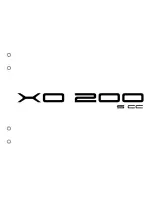
10-4
Section 10
Operation
C238
Each person onboard must have at least
one personal flotation device onboard and
one throwable device. Check the U.S. Coast
Guard standards for the correct type
required for your boat.
•
Make sure signal kits are onboard and
are in good operating condition and are
not expired.
•
Make sure you have sufficient water and
other provisions for the planned cruise.
•
Leave a written message listing details
of your planned cruise (Float Plan) with a
close friend ashore. Include a descrip-
tion of your boat, where you intend to
cruise, schedule of your arrival in the
cruising area and when you expect to
return. Keep the person informed of any
changes in your plan to prevent false
alarms. This information can tell authori-
ties where to look and your boat type in
the event you fail to arrive.
•
Check the amount of fuel onboard.
Observe the “rule of thirds”: one third of
the fuel for the trip out, one third to return
and one third in reserve. An additional
15% may be consumed in rough seas.
•
Check the water separating fuel filters for
water.
•
Turn on the battery switches.
•
Check for bilge water and for other signs
of potential problems. Monitor for the
scent of fuel fumes.
•
Test the automatic and manual bilge
pump switches to make sure the system
is working properly.
•
Have a tool kit and spare parts onboard.
The kit should include basic tools:
❑
Spark Plug Wrench
❑
Hammer
❑
Spark Plug Gap Gauge
❑
Electrician’s Tape
❑
Screwdrivers
❑
Lubricating Oil
❑
Pliers
❑
Jackknife
❑
Adjustable Wrench
❑
Vise Grip Pliers
❑
Needle Nose Pliers
❑
Wire Crimping Tool
❑
End Wrench Set
❑
Wire Connector Set
The spare parts kit should include:
❑
Extra Light Bulbs
❑
Spark Plugs
❑
Fuses and Circuit Breakers
❑
Flashlight and Batteries
❑
Drain Plugs
❑
Engine Oil
❑
Propellers
❑
Fuel Filters
❑
Propeller Nuts
❑
Fuel Hose and Clamps
•
Make sure all fire extinguishers are in
position and in good operating condition.
•
Make sure the shift control is in NEU-
TRAL.
•
Make sure the emergency engine stop
lanyard is attached to the operator and
the stop switch.
10.5 Operating your Boat
The operator must be seated, and ready
with the controls (steering/throttle) when the
engine is started or running.
After Starting the Engines:
•
Check engine gauges. Make sure all are
reading normally.
•
Visibly check engines to be sure there
are no apparent water, fuel or oil leaks.
•
Check operation of engine cooling sys-
tems.
•
Check controls and steering for smooth
and proper operation.
•
Allow engines to warm up for 10 to 15
minutes before operating them above
idle speeds.
•
Make sure all lines, cables, anchors, etc.
for securing the boat are onboard and in
good condition. All lines should be
coiled, secured and off the decks when
underway.
•
Have a safe cruise and enjoy yourself.
REMEMBER
:
When operating a boat, you accept the
responsibility for the boat, safety of passen-
gers and others out enjoying the water.
Summary of Contents for C238
Page 1: ...October 2015 December 2015...
Page 2: ...NOTICE This manual may contain pictures or discussions of options not available on SE models...
Page 6: ......
Page 10: ...Operator Notes 8 C238...
Page 20: ...Operator Notes 2 6 C238...
Page 34: ...5 6 Operator Notes C238...
Page 36: ...6 2 Operator Notes C238...
Page 42: ...8 2 Operator Notes C238...
Page 50: ...Operator Notes 9 8 C238...
Page 74: ...12 6 Operator Notes C238...
Page 80: ...Operator Notes A 6 C238...
Page 82: ...Appendix B Maintenance Log Date Hours Dealer Service Repairs B 2 C238 Maintenance Log...
Page 83: ...Maintenance Log B 3 Appendix B C238 Date Hours Dealer Service Repairs...
Page 84: ...Appendix B Maintenance Log Date Hours Dealer Service Repairs B 4 C238...
Page 85: ...Boating Accident Report C 1 Appendix C C238 Boating Accident Report...
Page 86: ...C 2 Appendix C Boating Accident Report C238...
Page 87: ...Float Plan D 1 Appendix D C238 Float Plan...
Page 88: ...Operator Notes D 2 C238...
Page 92: ...Operator Notes E 4 C238...
Page 93: ...Schematics F 1 Appendix F C238 Schematics...
Page 94: ...F 2 Appendix F Schematics C238...
Page 95: ...Schematics F 3 Appendix F C238...
Page 96: ...F 4 Appendix F Schematics C238...
Page 97: ...Schematics F 5 Appendix F C238...
Page 98: ...F 6 Appendix F Schematics C238...
Page 99: ...Schematics F 7 Appendix F C238...
Page 100: ...F 8 Appendix F Schematics C238...
Page 101: ...Schematics F 9 Appendix F C238...
Page 102: ...F 10 Appendix F Schematics C238...
Page 103: ...Schematics F 11 Appendix F C238...
Page 104: ...F 12 Appendix F Schematics C238...
Page 105: ...Schematics F 13 Appendix F C238...
Page 106: ...F 14 Appendix F Schematics C238...
Page 107: ...Schematics F 15 Appendix F C238...
Page 108: ...F 16 Appendix F Schematics C238...
Page 109: ...Schematics F 17 Appendix F C238...
Page 110: ...F 18 Appendix F Schematics C238...
Page 111: ...Schematics F 19 Appendix F C238...
Page 112: ...F 20 Appendix F Schematics C238...
Page 113: ...Schematics F 21 Appendix F C238...
Page 114: ...F 22 Appendix F Schematics C238...
Page 115: ...Schematics F 23 Appendix F C238...
Page 116: ...Operator Notes F 24 C238...
Page 117: ......
Page 118: ......
















































